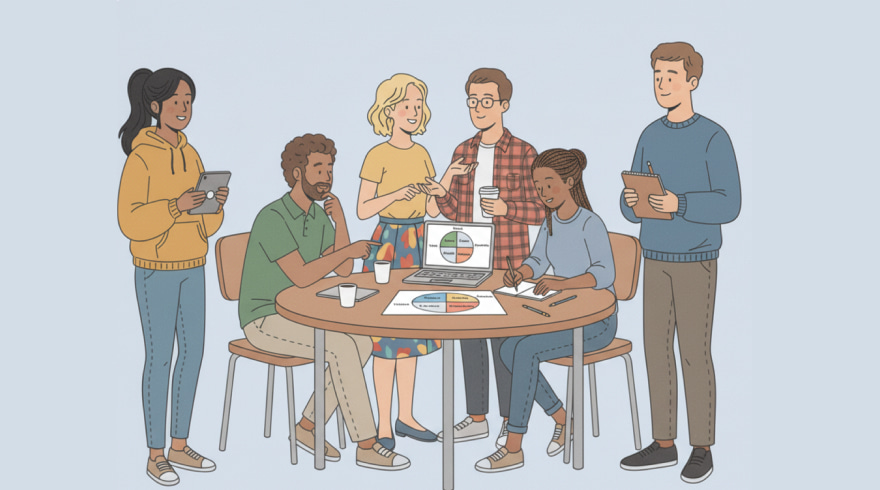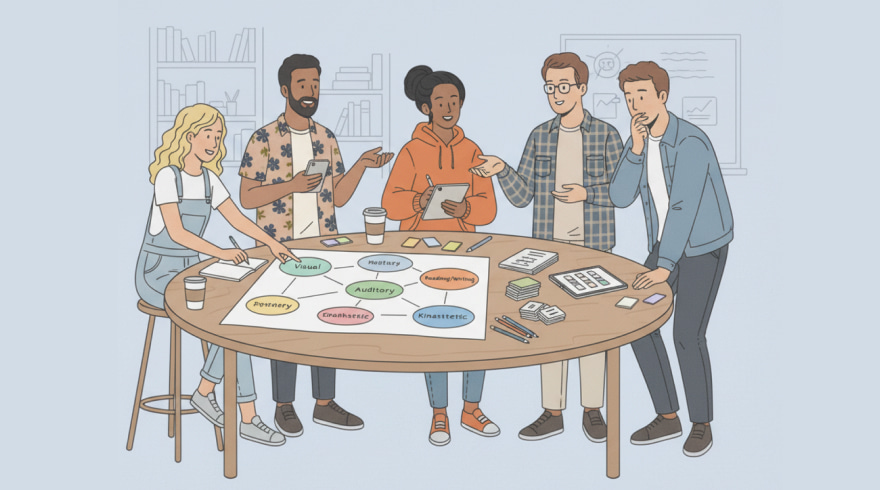Understanding and Using Multiple Intelligences: A Complete Assessment Guide
- 31 October 2025

Foundations of Multiple Intelligences Test
Human capability is a mosaic, not a single metric, and this insight sits at the heart of the multiple intelligences perspective. Instead of ranking people on a narrow academic scale, this framework maps a spectrum of cognitive talents that show up in classrooms, studios, labs, playgrounds, and workplaces. The idea invites a kinder, more accurate look at how people learn, create, decide, and solve problems, while also providing practical direction for instruction and coaching. When we honor varied aptitudes, we unlock motivation and reveal pathways that standard tests often miss.
In day-to-day practice, educators and leaders want tools that turn theory into clear, actionable data they can use right away. In this context, a thoughtfully designed multiple intelligences assessment offers a formative snapshot of preferences, strategies, and patterns that individuals rely on during learning and performance. With that information in hand, mentors can match tasks to strengths, build scaffolds for challenges, and blend modalities to improve engagement. The outcome is not labels or limits, but a broader repertoire for teaching and training that respects both depth and diversity across learners.
- Helps learners articulate strengths with specific language and examples.
- Guides teachers in differentiating content, process, and products.
- Informs goal setting, study strategies, and project design.
- Reveals overlooked talents that enhance collaboration and leadership.
- Builds confidence by validating nontraditional forms of excellence.
How Mi Profiling Works: From Items to Insights
Good instruments balance psychometric care with practical clarity, translating abstract constructs into observations, choices, and scenarios that feel authentic. Items may ask respondents how they prefer to study, which puzzles they enjoy, how they approach group work, or what kinds of environments boost focus. A composite profile then emerges, highlighting relative strengths and potential synergies among domains such as linguistic, logical-mathematical, spatial, musical, bodily-kinesthetic, interpersonal, intrapersonal, and naturalistic capacities.
Interpretation becomes truly valuable when it links scores to strategy menus and concrete next steps. In many programs, scoring rubrics pair each domain with specific learning methods, practice routines, and feedback cues. Within this interpretive flow, the phrase assessment of multiple intelligences refers to the structured process of gathering responses, calculating indicators, and contextualizing results with developmental and situational factors. Rather than chasing a definitive label, the approach emphasizes patterns over time, triangulation with performance artifacts, and reflection that deepens self-awareness.
- Use triangulation: combine survey results with portfolios and observation notes.
- Consider context: stress, language, and prior knowledge can shift responses.
- Reassess after interventions to see which strategies move the needle.
- Map results to specific tasks, not vague categories, for immediate utility.
When profiles inform classroom design, you often see choice boards, multimodal projects, and varied assessment options. In teams, leaders might assign roles that capitalize on social navigation, pattern analysis, or spatial visualization. Over time, a feedback loop forms: tactics improve outcomes, better outcomes reinforce strengths, and new strengths open fresh opportunities to learn and contribute.
Benefits and Use Cases: Education, Career Development, and Team Performance
The practical upside of profiling cognitive diversity shows up across the learning lifespan. In K–12, teachers use profiles to pair texts with diagrams, labs with fieldwork, and practice drills with rhythm or movement, elevating both equity and achievement. In higher education, advisors tailor study plans and project roles so students thrive in research groups and capstone teams. In the workplace, managers leverage complementary strengths to boost innovation, resolve conflict, and increase psychological safety, especially in cross-functional projects demanding hybrid thinking.
For those seeking alignment with theory, the widely cited gardner multiple intelligences assessment is often discussed in professional learning communities as a way to connect scholarly constructs with day-to-day teaching. Practitioners report clearer student voice, richer portfolios, and more resilient study habits when learners can name and train their preferred modalities. Another advantage is inclusivity: multimodal pathways create on-ramps for multilingual learners, neurodivergent thinkers, and individuals whose talents emerge outside traditional testing environments.
- Personalization: tailor instruction to fit strengths and stretch zones.
- Engagement: increase flow by matching tasks with preferred modalities.
- Retention: anchor new knowledge using multiple sensory channels.
- Collaboration: assemble balanced teams with complementary abilities.
- Wellbeing: reduce frustration by aligning effort with authentic talents.
These benefits compound when institutions adopt a shared language for strengths. Clear descriptors make collaboration smoother, feedback more precise, and goal setting more attainable, creating a culture where learners and professionals grow with purpose.
Quick Reference: Mi Domains, Strength Indicators, and Strategy Starters
Overview charts make the landscape of abilities easier to navigate, especially for people new to the model. The table below summarizes each domain with common strength indicators and simple, actionable strategies you can try immediately in class, study sessions, or team meetings. Use it as a springboard for deeper planning, not a rigid prescription, and always adjust tactics to context, age, culture, and task demands so the guidance remains responsive and humane.
| Domain | Typical Strength Indicators | Strategy Starters |
|---|---|---|
| Linguistic | Love for words, storytelling, debating, rich vocabulary | Journals, debates, summaries, explain-to-teach activities |
| Logical-Mathematical | Pattern detection, sequencing, quantitative reasoning | Puzzles, data charts, proofs, algorithm mapping |
| Spatial | Mental rotation, diagramming, visual memory | Sketch-notes, mind maps, design mockups, models |
| Musical | Rhythm sensitivity, melodic recall, tonal awareness | Rhythmic mnemonics, playlists, sound cues |
| Bodily-Kinesthetic | Hands-on learning, expressive movement, coordination | Labs, role-play, manipulatives, walk-and-talks |
| Interpersonal | Social attunement, facilitation, collaborative problem solving | Peer coaching, group protocols, stakeholder interviews |
| Intrapersonal | Self-reflection, values clarity, independent focus | Goal journals, metacognitive prompts, solo sprints |
| Naturalistic | Systems awareness, patterning in nature, classification | Outdoor observation, datasets, environmental case studies |
To deepen self-knowledge, many learners complement surveys with reflective prompts, progress trackers, and short experiments that test which study tactics yield better results. In this reflective mode, a concise multiple intelligences self assessment can serve as a catalyst for trying new strategies, gathering evidence, and iterating toward a personalized learning playbook that evolves as skills grow and goals change.
- Run two-week sprints testing different modalities on the same task.
- Track energy, focus, and outcomes to identify high-yield methods.
- Pair a strong domain with a developing one to build cross-ability bridges.
- Share findings with peers to expand your menu of tactics.
Implementing Mi in Practice: Ethical Use, Interpretation, and Continuous Improvement
Responsible use starts with clarity: communicate that results describe preferences and emerging capacities, not fixed limits or innate destinies. Invite learners to see profiles as hypotheses to test, not verdicts to accept. Pair data with reflection activities, learning logs, debrief conversations, and portfolio reviews, so students and teams can connect insights to lived experience. When patterns seem surprising, gather more evidence through projects, observations, and feedback from multiple contexts.
For institutions, the next step is alignment. Course maps, unit plans, and professional development should reflect multimodal design, with rubrics that value multiple ways to demonstrate mastery. Technology can help: authoring tools support mixed media, adaptive systems recommend varied practice, and analytics highlight which combinations drive performance gains. Equally important is equity: multimodal pathways must be accessible, culturally responsive, and co-created with learners to avoid one-size-fits-all checklists that miss nuance.
- Set clear success criteria and offer at least two demonstration options.
- Audit materials for representation and access across modalities.
- Provide feedback that names strategies, not just outcomes.
- Revisit profiles each term to capture growth and new interests.
As the cycle repeats, organizations build a culture of experimentation. The result is not only better grades or productivity, but also stronger identity, agency, and community, key ingredients for lifelong learning and resilient performance in complex, changing environments.
FAQ: Common Questions About Mi Tools and Profiles
How reliable are MI instruments compared to traditional tests?
Reliability depends on design quality, clarity of items, sample size, and consistent administration. While traditional tests often target narrow constructs, MI tools aim to surface patterns across contexts, so triangulation with portfolios and observations is recommended. Over multiple administrations, stability tends to improve as respondents gain self-awareness and as raters calibrate their judgments.
Can MI profiles change over time?
Yes. Exposure to new tasks, deliberate practice, and changing roles can shift both preferences and performance. Profiles are best treated as dynamic snapshots that benefit from periodic review, especially after significant learning experiences, project cycles, or life events that influence motivation and opportunity.
Should teachers grade based on MI domains?
Grades should reflect standards and learning goals, not preferred modalities. However, instruction and assessment design can offer varied pathways and products so learners demonstrate mastery in multiple ways. This approach preserves rigor while enhancing access and engagement for diverse thinkers.
How can teams use MI insights without stereotyping members?
Use profiles as conversation starters, not boxes. Rotate roles to develop breadth, pair complementary strengths for complex tasks, and debrief how strategies helped outcomes. Keep the focus on observable behaviors and results, and revisit agreements as projects evolve.
What are practical first steps for schools new to MI?
Begin with a pilot: train a small cohort, select a short unit for redesign, and collect evidence on engagement and achievement. Share findings, refine tools, and scale gradually with professional learning that models multimodal practices and ethical interpretation.
As you explore instruments and classroom strategies, remember that a reflective assessment of multiple intelligences process thrives when paired with empathy, iteration, and a commitment to honoring every learner’s way of knowing and performing.
Latest News
-
![A Complete Guide to the VARK Model and Personalized Learning Preferences]() A Complete Guide to the VARK Model and Personalized Learning Preferences Take Learning Style Assessment Online Get Started What VARK Is and Why Learning Preferences Matter The VARK framework classifies how individuals tend to absorb, process, and recall information across four modalities: Visual, Aural, Read/Write, and Kinesthetic. Instead of c...
A Complete Guide to the VARK Model and Personalized Learning Preferences Take Learning Style Assessment Online Get Started What VARK Is and Why Learning Preferences Matter The VARK framework classifies how individuals tend to absorb, process, and recall information across four modalities: Visual, Aural, Read/Write, and Kinesthetic. Instead of c... - 3 November, 2025
-
![The Complete Guide to Understanding and Using Learning Style Assessments]() The Complete Guide to Understanding and Using Learning Style Assessments Take Learning Style Assessment Online Get Started Why Understanding Your Learning Style Matters Most people study harder when they could study smarter, and that difference often stems from knowing how the brain prefers to take in, transform, and remember information. A tho...
The Complete Guide to Understanding and Using Learning Style Assessments Take Learning Style Assessment Online Get Started Why Understanding Your Learning Style Matters Most people study harder when they could study smarter, and that difference often stems from knowing how the brain prefers to take in, transform, and remember information. A tho... - 30 October, 2025
-
![The Guide to Personalized Learning Preferences and Reflective Evaluation]() The Guide to Personalized Learning Preferences and Reflective Evaluation Take Learning Style Assessment Online Get Started Why Personalizing How You Learn Changes Results Most people study harder when they feel progress is within reach, yet effort alone doesn’t guarantee improvement. The real unlock is making your study tactics fit the wa...
The Guide to Personalized Learning Preferences and Reflective Evaluation Take Learning Style Assessment Online Get Started Why Personalizing How You Learn Changes Results Most people study harder when they feel progress is within reach, yet effort alone doesn’t guarantee improvement. The real unlock is making your study tactics fit the wa... - 29 October, 2025



